Pipe cleaning cable: types, how to choose the right one + instructions for use
When chemical means of eliminating blockages in a siphon or sewer do not work, a rigid plumbing cable for cleaning pipes comes to the rescue - with its help you can eliminate the problem in one go.
To work with the equipment, you do not need to have special qualifications; the main thing is to choose the right cable and follow the simple rules for its use. The article is devoted to solving these issues.
We suggest you figure out which tool is best to use in a given situation, and which attachments are suitable for cleaning sewer pipes. The instructions we offer will help you clear the blockage yourself, without waiting for a plumber to arrive.
The content of the article:
Types of blockages and their causes
Before purchasing a cable to remove a sewer plug, it is necessary to determine the cause of the blockage, because in some cases it is mechanical and chemicals turns out to be insufficient and the only solution to the problem is to disconnect the pipes.
All blockages are divided into three categories:
- mechanical;
- operational;
- technological.
Mechanical blockages most often occur due to the fault of children who lower large toys or household items into the toilet or bathtub.
They partially block the pipes and trap fibrous structures and hair.Such blockages rarely completely block the flow of water and lead to emergency situations. Eliminating the problem often ends with dismantling the pipes.
Operational blockage periodically forms in pipes with a slight slope and a large amount of greasy waste. The inner surface of the pipes slowly becomes overgrown with fat, to which hair, food particles and mechanical impurities stick.
Over time, the capacity of the highway decreases, and sewer needs flushing. It is best to eliminate operational blockages using cables.
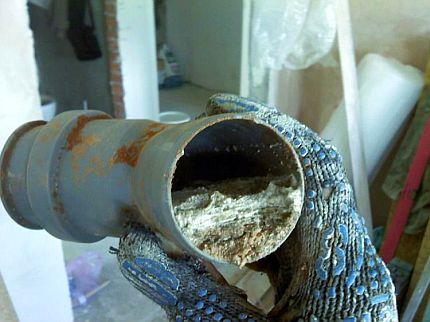
Technological reasons pipes being clogged with debris are a consequence of gross design errors and installation of sewer systems. Solid particles and fat deposits quickly accumulate in pipes and bends with insufficient slope.
After eliminating such a blockage, it is important to exclude its cause, otherwise in a few weeks you will have to clean the pipes again.
Each blockage has not only its own cause, but also optimal means of elimination. One of the options for cleaning pipes is the proven mechanical method using plumbing cables of various designs.
Types of plumbing cables
Due to the large number of manufacturers of plumbing cables, the options for making their cords and endings are quite varied. All devices are often united only by a handle for scrolling the cable along the axis. Almost all models are equipped with it.
According to their internal structure, cables are divided into the following types:
- cable;
- spring;
- spring-wound.
These cables are used for various blockages and require more detailed consideration.
Type #1: Rope Wire
The rope type of cable is the simplest solution for cleaning apartment drains. It has the form of a cord twisted from spirally twisted galvanized steel wires. Its thickness rarely exceeds 6 mm, and its length is usually 1.5-5 m.
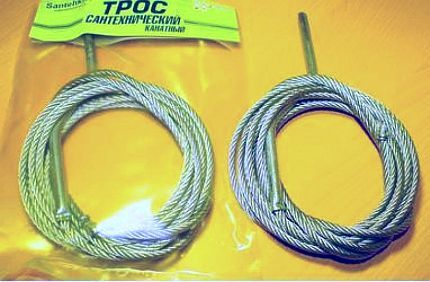
Features of rope rope:
- Withstands high torque in the direction opposite to the curl.
- Wear-resistant and durable.
- Weak penetration force due to small diameter.
- High probability of dissolution at the end.
- Not elastic, but has good passage through pipes and sewer bends due to its small thickness.
This cable is suitable for clearing small operational blockages in apartments. Poorly cleans fibrous and hair plugs.
Type #2: spring-wound cable
The spring-wound cable is not professional and is used on a par with the rope type for domestic purposes.
It represents a spring wire wound around a central void. The thickness varies between 5-10 mm, and the length is 2-5 meters.
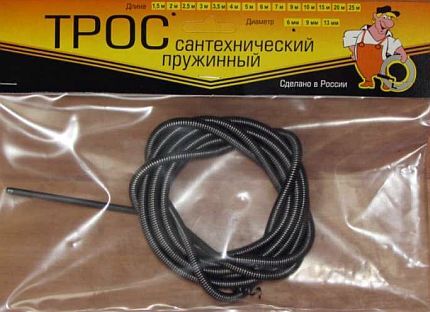
Features of the spring-wound cable:
- Withstands strong torque in the direction opposite to the curl.
- Very flexible, prone to forming loops in wide pipes.
- It is impossible to pull without irreversible longitudinal deformations if the end of the cable gets caught.
- Goes well around sewer bends.
- Not equipped with attachments.
- Difficult to maintain: hard-to-reach dirt accumulates in the internal cavity.
The flexibility of the spring does not allow creating a punching force, but the likelihood of damage to sewer joints is significantly reduced.
It is recommended to use a spring-wound cable to clear soft apartment blockages with a large number of bends in the sewer system.
Type #3: spring cable with core
The cable is a steel core made of twisted wire, which is wrapped around the outside with a spring spiral. The shaft diameter can be up to 30 mm, but the standard values are 13.5 mm and 16 mm. The length can reach 60 meters.
The spring cable is used not only for domestic needs, but also for breaking through severe blockages in intra-house risers and even in city sewers.
There are two main modifications of this cable:
- with a core rotating around the shell;
- with a rigidly fixed core.
Rigid-core devices are similar to rope-type cables. They consist of several layers of twisted wire, each of which is wound in the direction opposite to the previous layer. The last layer is wound in the form of a spring
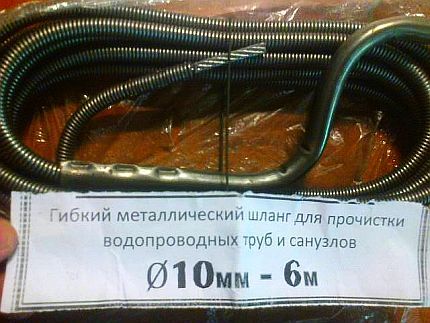
The result is a cable that is incredibly strong and resistant to torsion in any direction. At the end there is usually a mount for a nozzle.

In a cable with a core rotating around the sheath, the last layer is wound with a gap. The end of the core has a mount for a nozzle. The twist handle is attached directly to the core.
This design allows you to push the cable inside the clogged pipe over a long distance and clear the clog with a nozzle only at the exit from the outer shell.
Features of core spring cable:
- withstands strong torque;
- has high penetration ability;
- sewer deposits do not spray out from the cable when twisting;
- not flexible, does not fit into straight bends well;
- does not scratch the entire length of the pipe being cleaned;
- equipped with nozzles.
A spring cable with a rotating internal shaft is often used by professional plumbers, but at home it can also break through a blockage without any problems.
Additional equipment for cables
In addition to the cable itself, there is additional equipment that facilitates the process of clearing the blockage.
It includes the following devices:
- manual spinner with cable drum;
- electric machine for torsion and winding of cable;
- nozzles;
- flexible shells.
Electrical and mechanical drain cleaning devices make the process of twisting and winding the cable easier. Using a drum allows you not to twist the entire dirty cable located outside and not splash dirt around the bathroom.
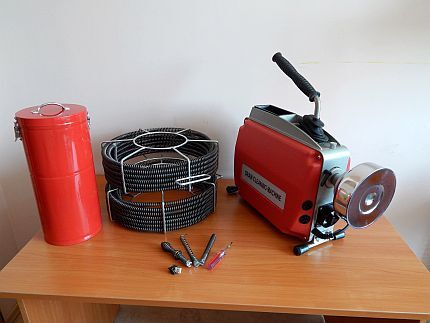
Nozzles on the end of the cable are used to increase the efficiency of eliminating blockages, depending on the type of debris and the diameter of the pipe being cleaned. And the rubberized coating of spring models makes it easier to pass through pipes and speeds up cleaning the product after work.
Sewer cable attachments
Each plumbing cable is equipped with a special tip for cleaning pipes from debris. But at the end of a cheap rope rod, you can make a “rose” yourself by first winding a section 5-6 cm from the edge with copper wire so that the cable does not unravel further.
More expensive models have a threaded tip at the end for screwing on special attachments of the following types:
- Hook-shaped. Used to clear clogs containing hair and fibrous debris.
- Loop attachment. It is a widely wound spiral made of spring steel and resembles a kitchen whisk with a chopped off sharp end. Is a universal nozzle.
- Metal brush. Suitable for clearing dense wall deposits. Steel models strongly scratch plastic from the inside, so it is recommended to use them only in metal pipes.
- Pincer attachment. It is used to peel off fatty and viscous deposits on pipe walls.
- Lance-shaped piercing nozzle. Used to pass through dense deposits in highly restricted pipes. The working edge of the nozzle may have teeth to “bite” into the blockage during rotation.
Other types of tips: bottom, “rose”, horn-shaped, auger, etc.
You should ask the store immediately for the availability of nozzles, because the method of attaching them and the thread diameter may differ. The best option would be to purchase a cable complete with “original” tips.
Which cable is better to choose?
Before purchasing a plumbing cable, you need to decide on the factors that influence the choice of model.
These include:
- Maximum length from siphon to riser. You should not take a cable longer than this distance by more than 1 meter.
- Diameter of sewer pipes. The wider they are, the wider the cable must be, otherwise it may twist.
- Number of pipe turns. Most cored cables are designed for cleaning horizontal pipes and do not bend well at right angles.
When purchasing, preference should be given to those models that have a handle, a tip for screwing attachments, as well as an internal and external shaft.

Cables with mechanical and electrical torsion devices are very convenient, but they are not cheap, so their purchase is determined mainly by a person’s financial capabilities.
Step-by-step instructions for cleaning a sewer with a cable
Working with a plumbing cable does not require qualifications, and to successfully clear the blockage you only need to follow a number of rules discussed in the instructions below.
Preparatory stage
The first thing you need to do before cleaning is:
- Inspect the cable for damage, lubricate the bushings on the handle.
- Put on the nozzle, if available.
- Change into clothes that you don’t mind throwing away later.
- Remove nearby items that cannot simply be washed off afterwards.
- Cover the floor and equipment near the work area with oilcloth or rags.
Then it remains to pull the siphon corrugation out of the socket of the pipe being cleaned
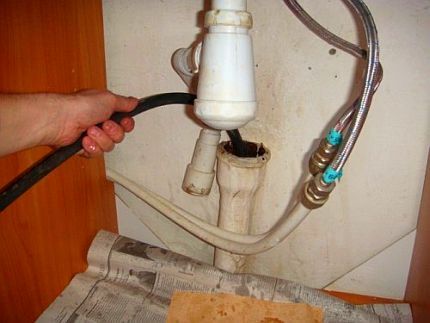
Before cleaning, it is advisable to fill the clogged riser with hot water. After the work site is completely ready, you can proceed directly to removing debris from the pipe.
Clogging phase
During the cleaning procedure, it is necessary to unwind the cable and slowly, with progressive movements, begin to push it into the pipe.
When resistance appears, it is necessary to switch to translational and rotational movements using the handle.

Rotational movements must be made constantly in one direction against the direction of winding the top layer of wires on the cable. When a blockage is reached, you need to increase the rotation and push the tip into the pipe. Cables with a rotating internal shaft can be tensioned - this increases their rigidity and penetrating ability.
If it is difficult to turn the cable, you need to regularly pull it out and clean it of dirt, otherwise it may twist inside a loop.
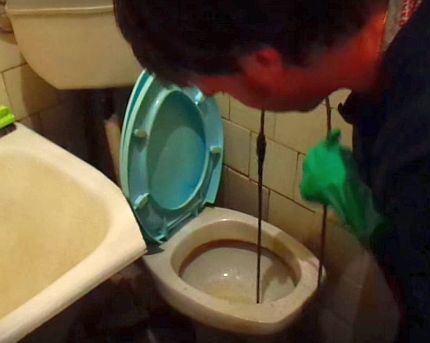
A negative consequence of excessive force when moving the cable can be damage to the tightness of the pipes at the joints with the appearance of leaks.
It is necessary to carry out translational-rotational movements and cleaning the cable until the blockage is completely eliminated.
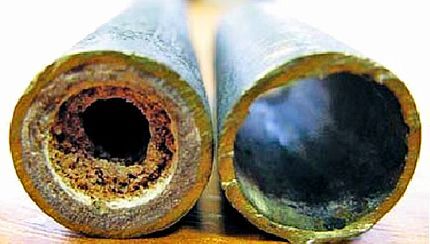
You can check the effectiveness of the action using warm water by pouring it into the drain hole from a water hose or a plastic bottle. If the water drains quickly, you can try inserting a siphon drain hose into the sewer socket and supplying maximum pressure of hot water to the sink.
Evidence of clearing the blockage will be the formation of a funnel at the drain hole.
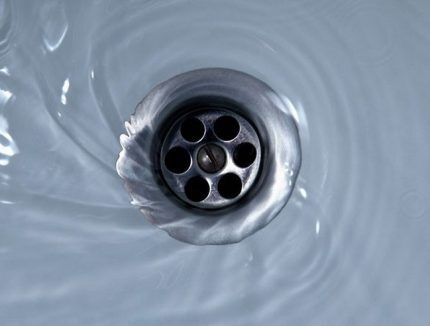
In order to prevent the formation of repeated blockages, it is necessary to install grease trap for sewer, which filters the incoming wastewater.
Final stage
After clearing the blockage you need to:
- Unscrew the siphon, clean it of dirt and reassemble it.
- Insert the corrugated drain hose into the sewer pipe.
- Check the tightness of the siphon and sewer system by pouring hot water into the sink with increasing pressure for 2-3 minutes.
If attempts to clear the blockage with a cable are unsuccessful, you will need to dismantle the sewer and remove the debris manually.
Step-by-step instructions for cleaning a toilet with a cable are given in this article.
Plumbing cable care
Contact of a metal cable with water is fraught with the appearance of rust and subsequent rupture of the wires that make it up. To maintain the functionality of the equipment, it is necessary to follow basic rules for its maintenance and care.
After use, the plumbing cable must be subjected to the following procedures:
- Use a rag to remove sewage.
- Rinse with warm water and detergent - the best choice is dishwashing liquid.For cleaning, you can use a brush with metal or hard plastic bristles.
- Wipe dry and let dry.
- Lubricate metal parts with universal machine oil. No need to lubricate with vegetable oil!
- Wrap in paper or place in a dry box.
Following the instructions described above will extend the life of the cable, remove the unpleasant odor coming from it and keep clothes clean when handling it.
If the blockage is not old, then you can try to eliminate it using alternative methods; for more details, see these articles:
- How to clean a toilet with a bottle: detailed description of the process + alternative methods
- How to clear a clogged sewer pipe at home: solutions + tips for prevention
Conclusions and useful video on the topic
Videos with practical lessons will help you clearly demonstrate the workflow for clearing clogged pipes using a plumbing cable. They show the specifics of using various equipment models and disclose the algorithm for their use.
Cleaning a sink drain:
Clearing a blockage using a drill and plumbing cable:
Removing a clogged sewer pipe using an electrical installation:
Clearing clogged drain pipes is quite simple. To do this, you should buy the necessary cable and follow the instructions described above. It’s better to take ten minutes to clean out debris from your pipes yourself than to suffer for months from a slow drain in your sink or bathtub.
If you have experience clearing cable blockages, please share the information with our readers. Tell us what tool and what attachment you used, or suggest an effective means for cleaning sewer pipes.You can leave comments in the form below.




Yes, without a good cable, you can’t even get close to cleaning the pipes. We had an old cable, when the pipe became clogged, they wanted to clean it. The attempts were in vain. All I had to do was buy a new cable, and everything was fine. Usually I do not clean alone, but with at least one assistant. It's much easier for a beginner. But our problem is that no one dried the cable after cleaning and it was immediately thrown into the storage room. There is a little rust, although this does not in any way affect the quality of cleaning. By the way, we have a rope cable.
I bought the cable so that: 1) it would pass into the bathtub drain hole without removing the siphon protective grille; 2) so that you can handle it alone. Honestly, I didn’t think about what type it was, but now I looked - spring-wound. I only use it to clean the pipes coming from the bathtub and sink; the blockages there are small, and that’s enough. But I couldn’t handle a serious rope alone; it requires male strength.
Cleaning with a cable requires not so much physical strength as dexterity. I cleared the blockage myself. My son, who was 8 years old at the time, helped a little. But, as you can understand, neither I nor he were distinguished by great physical strength. Although it might just be a simple blockage.
There was a case where my sewer was clogged, so tightly that nothing but a cable helped. By the way, I used a machine cable, steel, with a diameter of 8 millimeters, if not more. He was tough, he fought for a long time, but in the end he broke the plug. The end of the cable was simply unraveled into small wires.
Thank you, very informative. Well written.